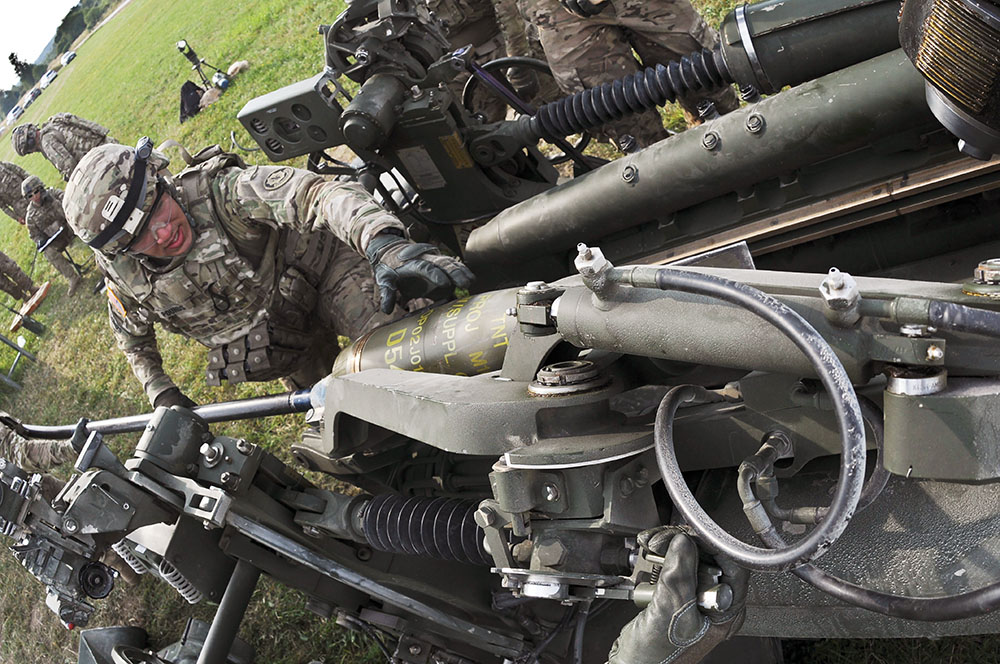
Selling military equipment to allied nations has many benefits—boosting our allies’ capabilities and thereby strengthening U.S. posture; facilitating military cooperation—but it’s a sensitive process that requires careful planning. PM CAS shares its four-step process to successfully handling FMS.
By Mr. Peter Burke and Mr. Ted Hom
Foreign military sales (FMS) require a tremendous amount of planning, preparation and sensitivity to the customer’s culture, values and needs. But most of all, they require solid communication among all stakeholders.
It is easy to identify these tenets, but to execute them is certainly a challenge. The challenge is worth it, though, because FMS build strategic relations, and result in an improved U.S. defense posture, partner nation security and interoperability with nations. FMS also saves the Army money, because buying a larger order with partner nations leads to a lower per-unit price.
In today’s environment, with increasing hot spots in the Middle East and Western Europe, rumblings in the Pacific Rim and limited military resources, FMS are becoming a more important mechanism to train, equip and operate with our allies.
STEP ONE: BUILD A GOOD PRODUCT
The Precision Guidance Kit (PGK) is a good case study of what it takes to create a successful FMS case. The PGK is a GPS device with fuzing functions, and uses GPS and control surfaces to guide 155 mm projectiles to the programmed target grid with a high degree of accuracy, reducing collateral damage and enabling quicker success. It is an Acquisition Category (ACAT) Level II effort, achieving urgent materiel release in March 2013 and anticipated to secure type classification-standard/full materiel release (TC-STD/FMR) in the first quarter of FY16. The kit meets international standards for safety and compatibility, and is attractive for FMS because it turns a conventional stockpile of 155 mm projectiles into near-precision munitions.
It’s capable of mitigating the shortcomings of current area engagement munitions by enabling the maneuver commander to engage critical targets, including fleeting and “short dwell” targets, with increased accuracy and effectiveness. Without the high performance and high degree of compatibility, few nations would want to buy the PGK.
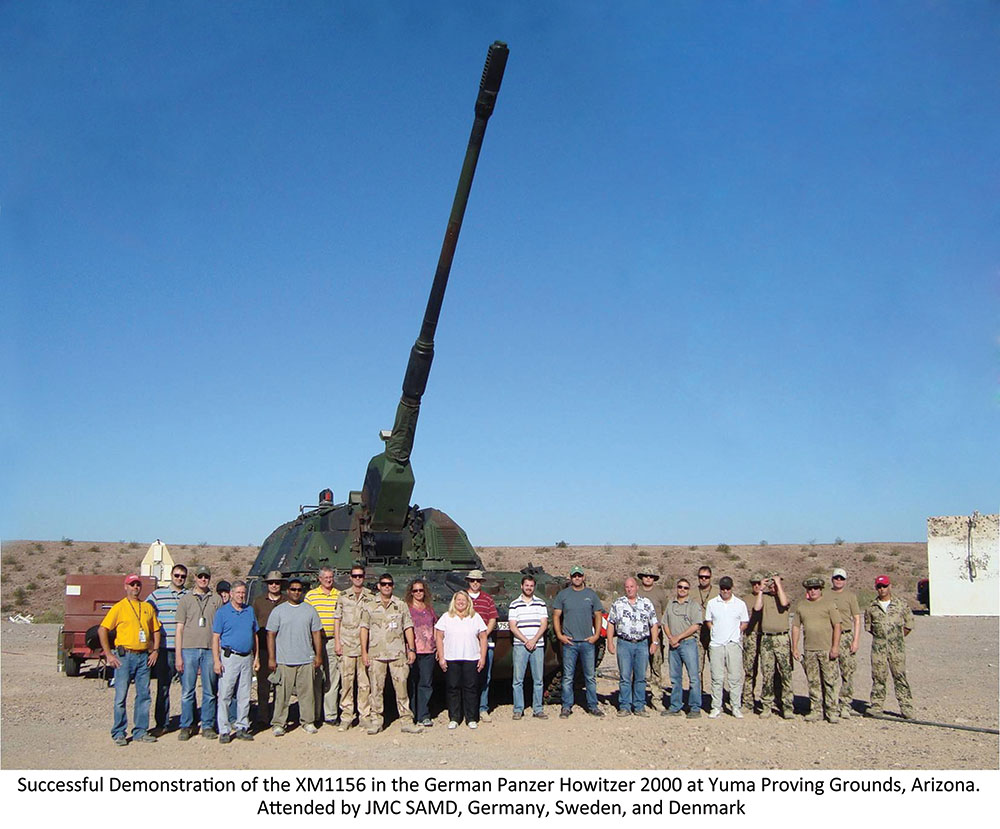
INTERNATIONAL EFFORT
Representatives from Picatinny Arsenal, JMC, Germany, the Kingdom of Sweden and Denmark after a successful demonstration of the XM1156 PGK in the German Panzer Howitzer 2000 at YPG. (Photo courtesy of YPG Public Affairs)
STEP TWO: BUILD RELATIONSHIPS
Solid performance of equipment is just the first threshold to enable the interplay of different stakeholders to go forth with a possible FMS case. The Office of the Project Manager for Combat Ammunition Systems (OPM CAS) is a proactive player in the early stages of the FMS case development.
Within the PGK program, OPM CAS developed solid working relations with many partners before embarking on the sale. These partners included United States Security Assistance Command (USASAC), Redstone Arsenal, AL; Joint Munitions Command (JMC), Rock Island, IL; Department of the Army-Defense Export Cooperation (DASA(DE&C)), Washington, DC; different Offices of Defense Cooperation (ODCs); U.S. embassies worldwide; Program Executive Office Ammunition (PEO Ammunition), Picatinny Arsenal, NJ; and Army Test and Evaluation Command’s facility at Yuma Proving Ground (YPG), AZ.
The success of the PGK depends on its interfaces with the projectile, weapon, fire-control system and GPS constellation. In other words, a potential customer cannot simply procure the item off the shelf. The PM office, as the center of this indirect-fire ecosystem, is responsible for evaluating how the PGK will work on a candidate weapon system, which may be significantly different from what it was qualified on in the United States. Recognizing this early in the strategic planning for FMS, PM CAS took action to build up an in-house capability to quickly evaluate foreign systems’ compatibility with PGK in order to have a realistic scope of work in hand during discussions with candidate buyers.
The coordination of different stakeholders, with strong communication brokered by the PM, is also critical in paving the way to develop and execute an FMS case. Constant follow-up and status updates help keep the case flowing.
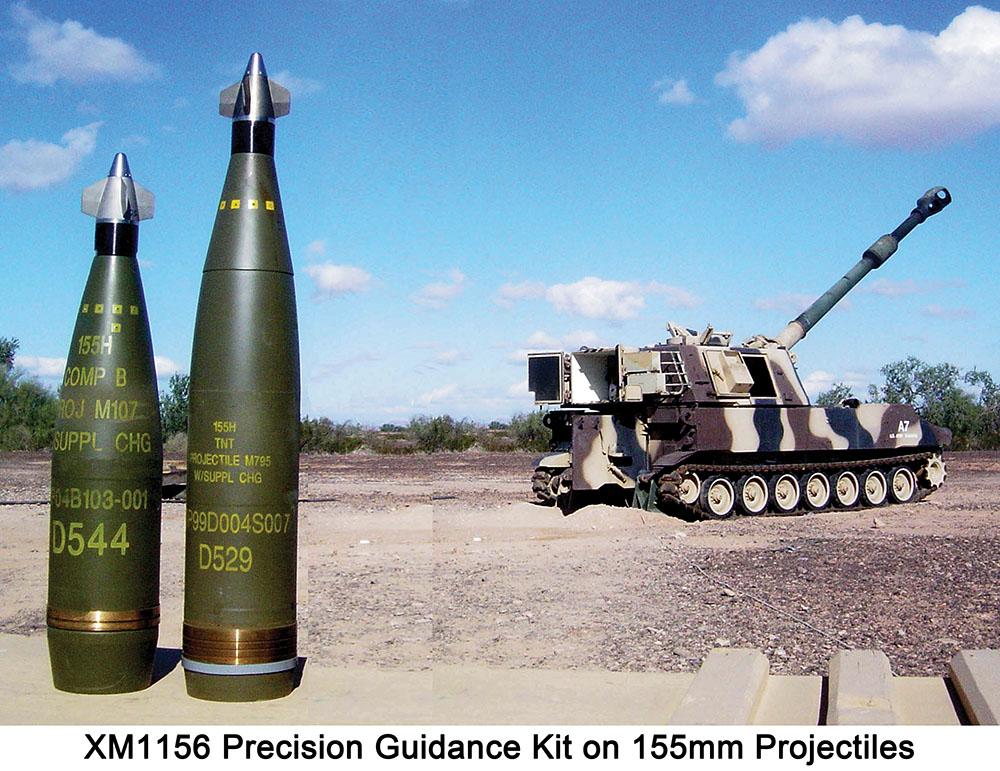
ON TARGET
PGK is a GPS with fuzing functions that uses control surfaces to guide 155 mm projectiles to a programmed target grid with a high degree of accuracy, reducing collateral damage. (Photo courtesy of YPG Public Affairs)
STEP THREE: KNOW THE BENEFITS
Besides the obvious benefits of interoperability and strengthening ties with our allies, FMS act as a strategic enabler to benefit the Army and the warfighter.
The PGK production contract was structured to realize a benefit from the economies of scale from higher volume production: The contract defined lower prices based on higher quantities ordered in a given period. As FMS orders come in, partner nation funding is added to the U.S. Army’s order, resulting in a lower average unit cost, enabling all to benefit with higher quantities for the same amount of funding.
STEP FOUR: HAVE A PLAN OF ENGAGEMENT
With these benefits in mind, OPM CAS developed a plan of engagement that has enabled successful foreign sales of the PGK. PM CAS briefs at international conferences, meetings or visits at Picatinny Arsenal, NJ, where PM CAS is located, presenting unclassified information regarding PGK, and often capturing the interest of the allied party because of the kits’ high performance and potential to greatly improve their indirect fire capabilities. The allied party typically has a national course-correction fuze requirement (adding a precision capability within the fuze module to improve conventional ammunition precision) and sees that PGK could possibly fulfill their needs.
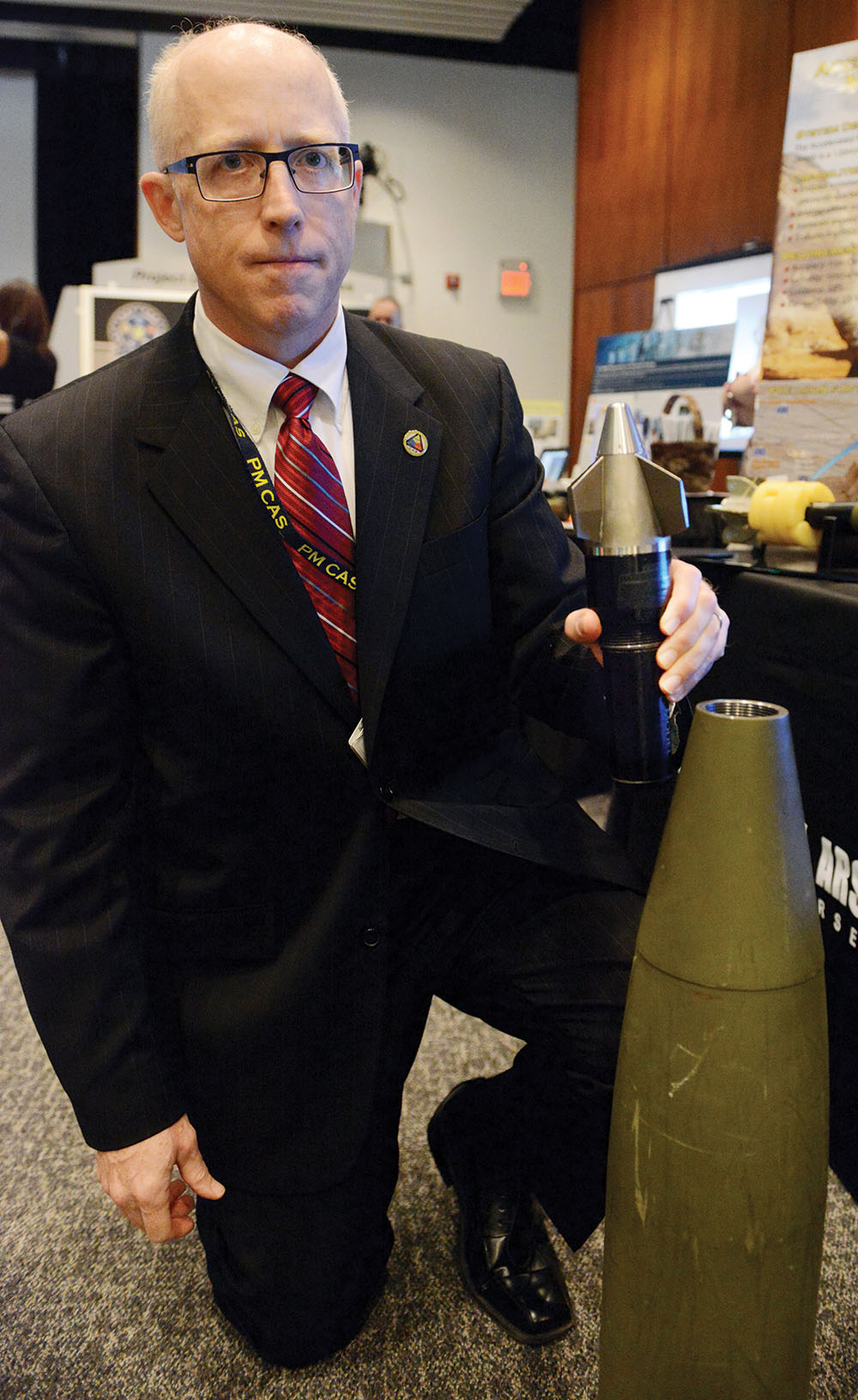
PGK PRESENTATION
Co-author Peter Burke shows the PGK separated from a 155 mm artillery projectile during media day at Picatinny Arsenal, May 4. Events such as this provide a venue to promote the device. (Photo by David Vergun, Defense Media Activity)
The allied nation will typically then request a follow-up unclassified PGK briefing in their country so more military and technical experts can evaluate the program. Briefings are typically presented by PM CAS at the U.S. embassy in the host nation, coordinated with the ODC of the host country, USASAC, DASA(DE&C) and PEO Ammunition.
Upon successful briefing and discussions, OPM CAS invites the interested nation to witness a PGK lot acceptance test at YPG. The week spent at Yuma with the country representatives, getting to learn more about PGK and building a strong relationship based on trust, is invaluable. This is the spirit of international cooperation and coalition building.
Just because the FMS case is signed does not mean that the work is over. Once an FMS case has been signed, its execution (conduct new equipment training, publish technical manuals, produce, ship and deliver defense articles) still requires care and diligence. The JMC case managers and the host-nation acceptance teams must work closely to ensure the defense articles and training materials are delivered and documented as promised. FMS program management reviews are critical to make sure all defense articles and services are identified and scheduled for delivery.
Allies have decided to partner with the United States on PGK based on this plan of engagement, with its strong communication framework. Furthermore, this framework has resulted in a 13 percent decrease in PGK production unit cost in FY15. This plan of engagement has also been applied successfully in other programs, such as the 155 mm Excalibur, a GPS-guided 155 mm artillery round and an ACAT Level I program that has been sold to Sweden, Canada and Australia, and can be used across other programs.
CONCLUSION
FMS case development and execution is a detail-oriented endeavor in meeting allied customer needs. Communication is the cornerstone of all the facets of FMS, including relationship building, interplay of national and international stakeholders, proactive follow-up, a solid plan of engagement and—of utmost importance—the highly reliable performance of equipment to be sold. All of these efforts result in our allies being able to fight shoulder to shoulder with us, using common equipment in present and future conflicts, and the economy of scale results in lower prices for the Army.
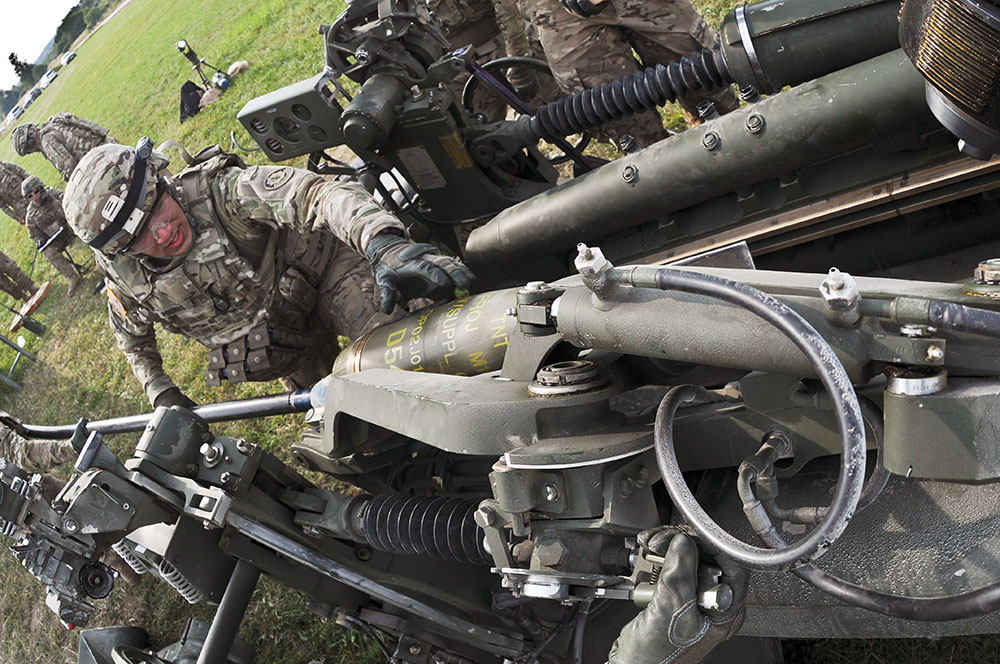
FMS Success
PFC Nathaniel Pounds, a cannon crew member assigned to Field Artillery Squadron, 2nd Cavalry Regiment, loads ammunition into an M777A2 Howitzer weapon system during an artillery demonstration, where they fired an XM1156 PGK for the first time in the regiment’s history at Grafenwoehr Training Area, Germany, July 24. The compatibility of the kit makes it an attractive FMS product for partner nations. (U.S. Army photo by Sgt. William A. Tanner, 2nd Cavalry Regiment)
For more information, contact the author at peter.j.burke.civ@mail.mil or 973-724-2110.
MR. PETER BURKE is the deputy project manager for PM CAS at Picatinny Arsenal. He is a graduate of the Harvard Business School (General Management Program), and holds an MBA from the Florida Institute of Technology and a B.S. in industrial engineering from the New Jersey Institute of Technology. He is Level III certified in program management and in systems planning, research, development and engineering (SPRDE) and is a member of the Army Acquisition Corps (AAC).
MR. TED HOM is the director of international programs for PEO Ammunition’s PM for Combat Ammunition Systems at Picatinny Arsenal. He holds an M.S. in national resource strategy from National Defense University, an MBA from Monmouth University, a graduate certificate in international relations for business from Boston University Brussels and a B.S. in chemical engineering from the State University of New York at Buffalo. He is Level III certified in program management and in SPRDE and is a member of the AAC.
This article was originally published in the October – December 2015 issue of Army AL&T magazine.
Subscribe to Army AL&T News, the premier online news source for the Acquisition, Logistics, and Technology (AL&T) Workforce. ![]() Subscribe
Subscribe







